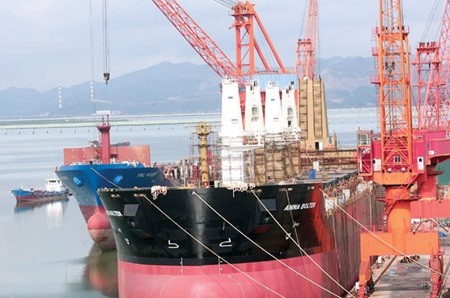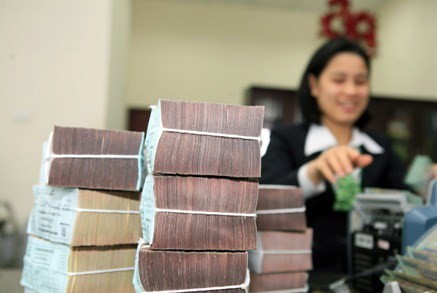(VOVworld) – In 2014, Vietnam’s economic restructuring program has focused on public investment, corporate, banking and financial reform. Despite worse results than hoped, the government’s efforts to boost economic restructuring have proven effective, creating a foundation to speed up the process in the next phase.
Since it began 3 years ago, the economic restructuring program has stabilized the macro-economy and kept inflation under control.

A 53,000-tonne ship is completed by Ha Long Shipbuilding Co Ltd. The National Assembly is seeking faster restructuring of State-owned enterprises, the banking sector and public investment in order to boost economic growth. — VNA/VNS Photo Huy Hung |
Building on the initial results, in 2014 the Vietnamese government stepped up its restructuring efforts, targeting a reform of economic institutions, establishing a new growth model, lowering inflation, and making it easier for businesses to grow rapidly and sustainably. Ministries and agencies have been asked to continue refining the legal foundation for restructuring public investment, state-owned enterprises, and the banking and financial system.
Doctor Nguyen Duc Kien, Vice Chairman of the National Assembly Committee for Economic Affairs, said: “generally, the government’s political will to restructure the national economy has been realized in laws which have begun to prove effective. Although the outcomes are still below expectations, the program has opened up an important direction.”
Since the beginning of 2014, 42 ineffective public projects have been cut to reduce scattered investment and waste. Long-term investment plans at the central and provincial level have been outlined to replace previous short-term plans. Human resources have been arranged according to set priorities.
As of the end of last month, 90 of 108 state-owned economic groups and corporations had been approved for SOE restructuring. 107 of 126 enterprises have been equitized and the rest have been merged. But according to Doctor Le Dang Doanh, more comprehensive equitization is needed to meet the set targets.
Doanh added “over the past few years, SOE restructuring has mainly aimed to equitize, not restructure comprehensively. That will require additional legal policies and closer supervision. What we need now is to develop projects that can be implemented feasibly, comprehensively, and more efficiently.”

State Bank of Vietnam governor Nguyen Van Binh: the government has already approved the second phase of the plan on banking and financial reform in which 6
or 7 more banks will be merged or restructured. |
To date, eight out of nine weak banks have been forced into mergers or takeovers as part of the ongoing plan to restructure and strengthen the banking system. The government has already approved the second phase of the plan in which 6 or 7 more banks will be merged or restructured. Bad debts have been addressed and the total reduced by half.
With the current economic restructuring, this year’s GDP growth is estimated to be 5.8%.